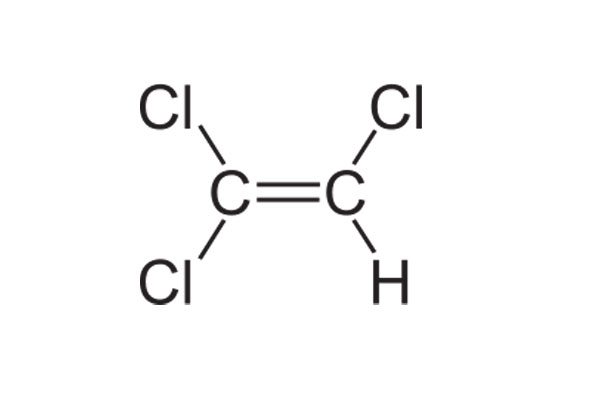Cas No: 67-64-1
EINESC No: 200-662-2
Molecular weight: 58.080 g/mol
Chemical Formula: C3H6O
Chemical Structure:
Physical Properties
General Properties:
Odor:
Intensity:
Boiling point:
Melting point:
Flash point:
Vapor pressure:
Refraction index:
Solubility (water)
Viscosity:

General Properties
Trichloroethylene is a luminous, colorless, non-volatile solvent that is formed from halogen compounds and it is commonly used in industry. It has many different names in trade business. It had been used as anaesthesia in the past. It is resticted now due to its hazardous nature. Although it is frequently used to clean metals, it cannot preserve its chemical structure when it contancts with metal. Ethyl methyl ketone is usually added to boost its stability.
It is a serious pollution source for underground waters and studies are still conducted to prevent this.
Production
Although many methods had been used in the past, trichloroethylene is now produced from ethylene. Firstly, it is put into reaction with iron chlorine to acquire dichlorine. Then, it is heated in 400 °C to acquire trichloroethylene. Mixtures of potassium chlorine or aluminium chlorine is geneally used as catalysts. Then, they are disintigrated via distillation.
Applications
Trichloroethylene is usually used as oil remover. It is used as solvent in dry cleaning, oil removing from metals and oil removig from cotton. It is also used as solvent in extraction processes, as a thinner in dyes and glues, as chemical intermediate substance in dyes and varnishes.
It is also used in coolant production. It possesses high heat transfering properties. It is also used to clean flue dust from rocket and jet engines.
It had been used as solvent for caffeine in tea and coffee, as anaesthesia for surgeries but it is now restricted due to its hazardous nature.
Safety Measures and Toxic Values
Trichloroethylene damages central nervous system when it is inhaled. This creates an anaesthetic effect. It may cause serious airway system diseases in high concentrations. It may also cause permanent damage to brain funtions and neural system. If exposed, it may cause serious head ache, vertigo, loss of conscience and even death.
It may also damage liver and kidneys. It causes Parkinson disease and it is carciogenic for animals. Studies have been conducted whether it causes chronic innate health diseases in newborns or not.
It is very hazardous to environment. It cumulates in underground waters and threatens the living beings in there. It must not be given to city network without necesary precaution. It creates both toxic and corrosive gases in high temperatures. Therefore, it must be stored in tighly closed containers and it should be handled carefully.